A projector is not an autonomous device. It has to be coupled with the projection screen, the choice of which, on the surface seems straightforward simply hanging an unpainted wall.
However, if you dig further into the matter, you may find out to be much more difficult than selecting your projector itself. Don’t worry, our guide can help you figure out which will be the most suitable best projector screen material for your requirements. Here’s our top 6 best screen materials.
1. Elite Screens Designer Cut Series
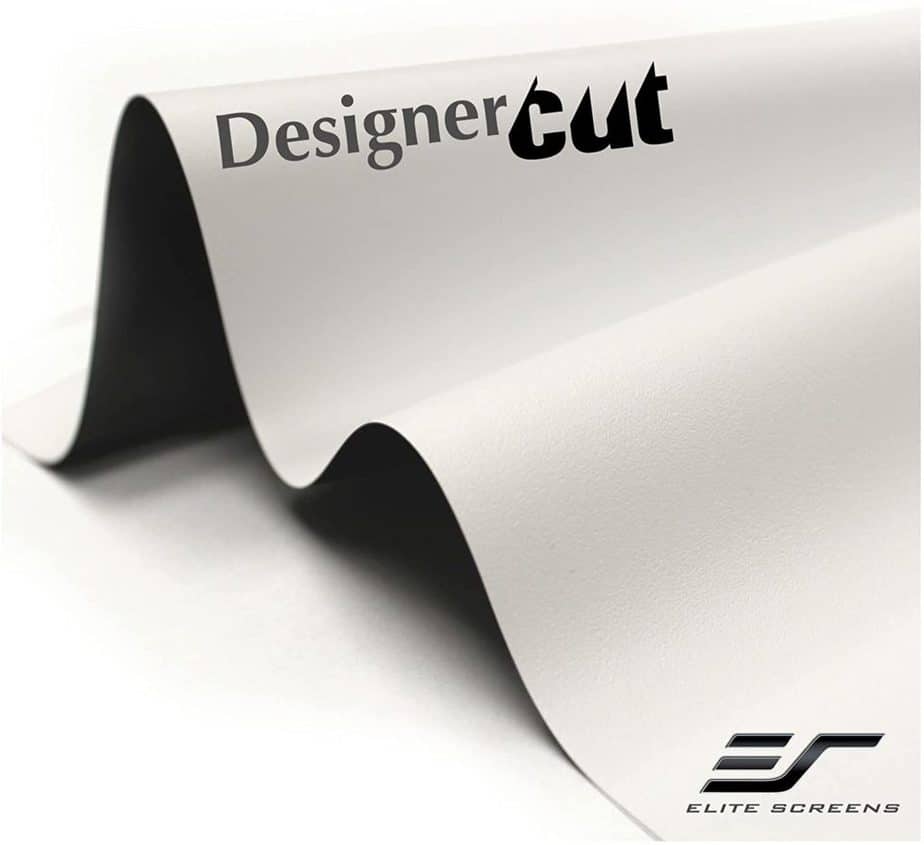
The best projector screen material thing with the Elite Screens Designer Cut Series is that it’s top-of-the-line in terms of quality, and not only in the way of branding. The dimensions of the whole set are 72 inches by the size of 125 inches. It’s designed for HD format videos that have the aspect ratio 16:9.
The Elite Screens Designer Cut Series product is an absolute cut above other products. Why? It’s because it uses the CineWhite material that is famous by its 1.1 gain. This is the most effective since the material’s color faithfully transmits what’s projected image without any color changes. It is also sufficiently reflective to enhance the brightness.
The advantage is small, but worth it. The screen is completely black-backed. This means that , like the blinds you use to block out light the screen will not let light escape. Therefore, the image you’re viewing will not become faded or weak because of the light escape.
Features:
- Color: Matte White.
- 160deg viewing angle.
- It measures 135 inches in length.
- CineWhite material type.
- It is covered by a two-year warranty.
- It’s about one hundred dollars.
- The dimensions are 72″ by 124″.
- Screen material raw that needs cutting.
- Blackout screen for black-backed projection.
- Durable and long-lasting screen material that you can count on.
- Produced by the USA to ensure quality throughout the board.
- Specifically makes use of CineWhite or ZRM-135HW-CINEWHITE as the material.
- It is a projector-specific format that can handle resolutions that range from FHD and up UHD 4K and even 8K (although they are not common).
2. Yescom projector screen material
The Yescom 177 16:9 DIY is quite a large. It has 449 centimeters to play with. This makes it bigger than Elite Screens CineWhite material that was mentioned above.
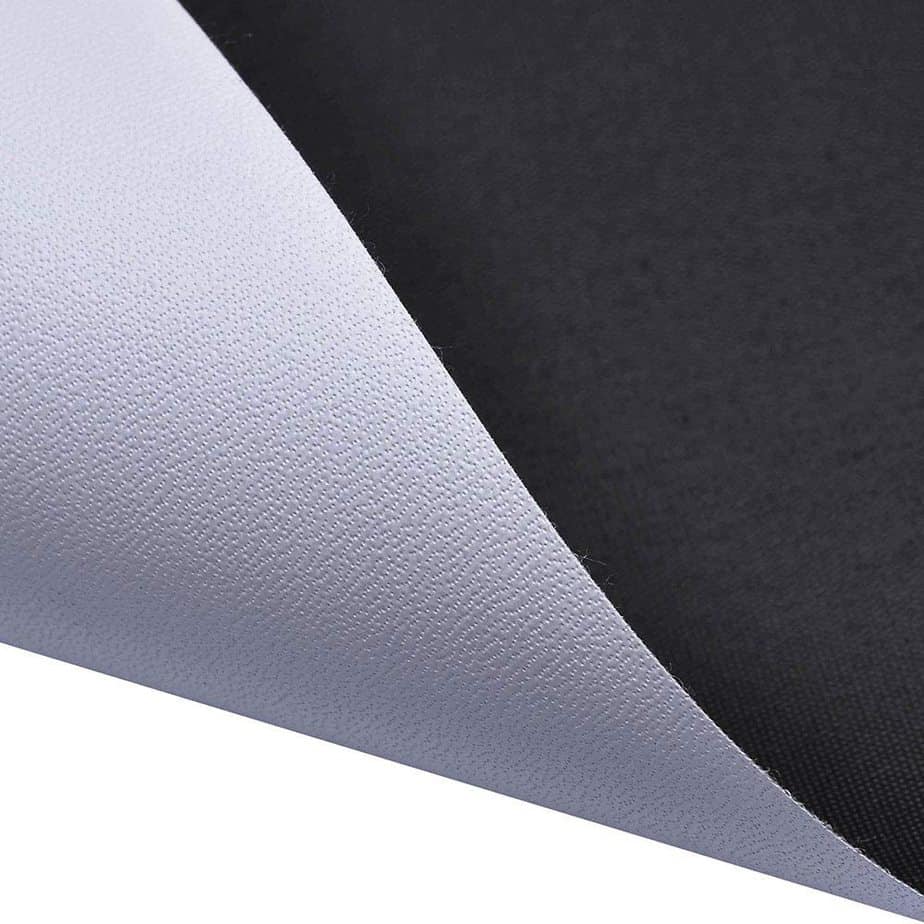
The Yescom is perfect for outdoor use like in your backyard to watch movies on evenings. It can, of course, be used as indoor projection screens too for example, those that are used in conference rooms or living rooms. The screen is able to block light due to the material’s regular black backing.
If the light escapes the film, the projection image quality won’t be as vivid. Due to its large viewing angle of 160 degrees, you’ll have an enormous viewing area that is ideal to watch the best cinematic widescreen movies that are packed with amazing details.
Features:
- It is an 1.1 increase.
- 160deg viewing angle.
- Its aspect ratio is 16:9.
- It works with front projection configurations.
- The width is 176 3/4″ or 449 centimeters.
- It’s about $80, but it could be more or less.
- It’s got PVC coated high-strength, high-strength screening material.
- The screen size for HTML0 of 86 5/8″ by 220cm 391cm.
- It is so strong that it can stand up to the elements outside.
- White viewing projection screen surface that diffuses uniformly the light to give the best results.
3. Taotaole projector screen material
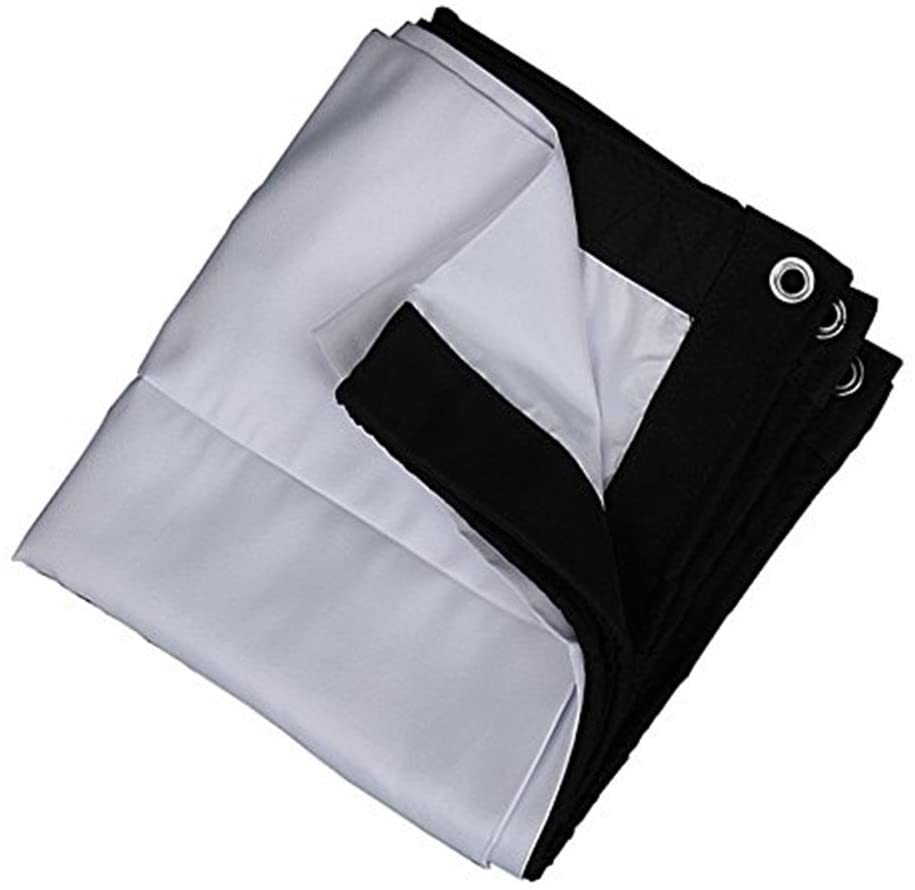
It’s the Taotaole Blackout Cloth measures 100 inches of portable DIY projector screen material that has blackout features. It’s best suited for the aspect ratio 16:9 It has polished edges and grommets that have been installed and it’s white.
It’s true that Taotaole doesn’t have the same acclaim as an industry name like Elite Screens, but it does the job and we’ve found it to be decent enough to make it onto this list of the top 9 screen materials that will be available for 2021. It’s not a lot of people who’ve made use of it, based on the number of reviews from users however, the “few” agree it’s topnotch.
It’s 4.06 feet by 7.27 feet, which is 48.72 inches by 87.24 inches. This means it’s smaller as Yescom as well as Elite Screens but for its cost, it’s an affordable option for screen makers who are DIY on the market. The price is also affordable from the fact that it’s an 1.0 improvement instead of 1.1 gain.
Features:
- Blackout cloth.
- It offers an 1.0 increase.
- 160deg viewing angle.
- It is best utilized inside.
- It is coated with an elastomer coating.
- It is used to project the front instead of rear projection.
- Composed of 30 percent cotton , and 70% polyester.
- Reinforced, heavy-duty border with grommets.
- Priced at fifty dollars (100 inches) and is available for around $700 (120 inches).
- It’s dimensions are 4.06 feet by 7.27 feet, or 48.72 inches 87.24 millimeters.
- This is 100 inches wide (another one is 120 inches).
4. Yandood screen material
The Yandood Screen Material Fabric composed of a specific matte white polymer that guarantees color saturation and high contrast in your images. It’s best to use it in environments that has a controlled ambient lighting. It’s best used in rooms with dark lighting.

This blackout fabric is made of EPPE polymer. This is distinct from traditional canvas glass fiber, white plastic or PVC. This makes the screen material more sustainable and meets E.U. REACH standards for testing. It is possible to see stunning images in this screen that are above 160deg.
The polymer material is also able to provide an improved viewing experience. Because of the 1.0 improvement, it can bring back color, and resolution can exceed 125 line pairs for each millimeter. Because it’s white it assures high-quality color. Other colors can affect the accuracy of color in the image, but grey is the best choice for higher contrast.
Features:
- 130-inch diagonal.
- 160deg viewing angle.
- Useful for front projection.
- 70″ x 118″ dimensions.
- The white one is around $80.
- Made for 16:9 aspect ratio images.
- Made up from EPPE Polymer Material.
- Compatible using the 4K Ultra Projector resolution in HD.
- It’s a screen that diffuses light material that has a fine matt surface.
- This white-colored surface ideal for image fidelity, specifically accurate color.
5. Elite Pull Down screen material
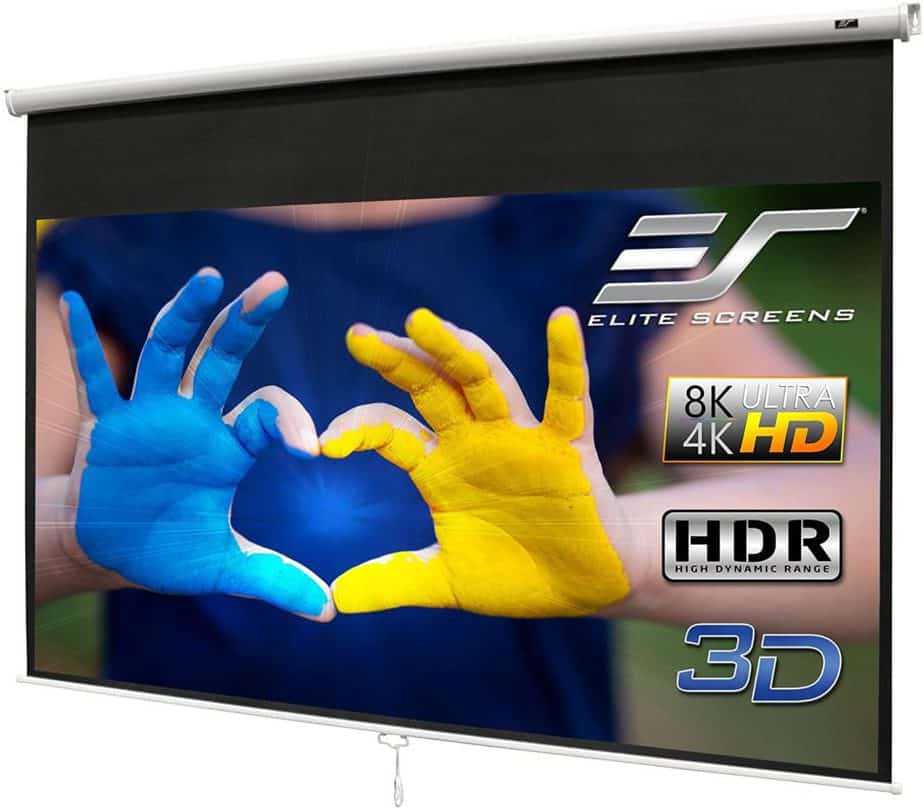
It is the Elite Screens Manual B Projector Screen is a 100-inch version of screen material that is suitable that is a manual pull-down screen. Manual B is able to achieve the same quality like Carl’s Blackout Cloth, but more users rate it as an equivalent. Therefore, it’s superior.
Technically speaking, this is more like an elongated screen rather than a screen material. It is a textured white matte surface, and can handle various aspect ratios like 1:1, 4:13, 16,:9 and 16:10. After you have released the handle and the fabric is pulled gradually back inside the housing.
The slow retraction mechanism makes sure that the screen’s retraction doesn’t become worn out quickly. Contrary to other fabrics, this has an auto-locking mechanism that can be adjusted to different heights. It is also compatible with HD, Ultra HD, HDR 4K, 8K and 3D.
Features:
- 0 Gain.
- Cost about $70.
- 160deg viewing angle.
- High Definition 4K and HDR Ready.
- 100 to 150 inches diagonal.
- 49″ by 87″, the size.
- Black-backed, bordered screen.
- It can be used 3-D active projectors.
- Height settings that can be adjusted and an the auto lock mechanism.
- Steel casing made of toughness available in white or black finishes.
- D-rings that are attached to the caps provide possibilities for suspended installations that can be used that can be used for the ceiling.
- A screen lanyard is included to facilitate operation, allowing you to perform screen pull downs.
6. 100BTF projector screen material
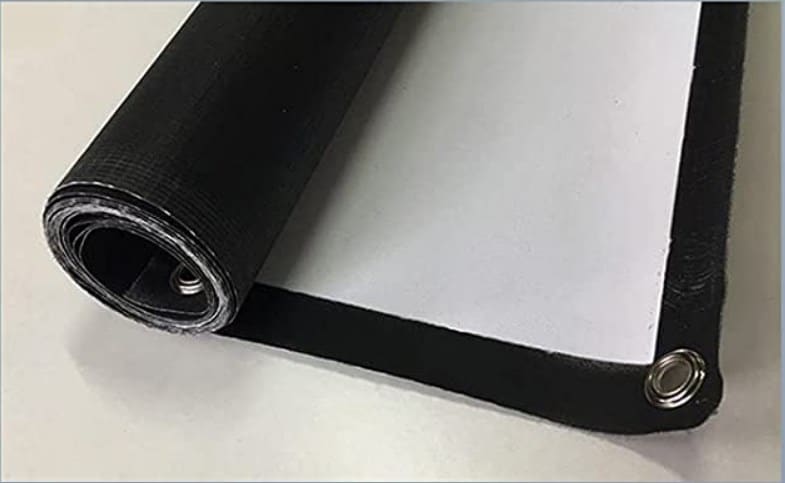
The 100BTF projector Screen With Stand high-end 135-inch projection screen, with three layers of PVC to make its fabric. The screen is also foldable and anti-crease to ensure the screen can be utilized outdoors and indoors.
The display’s projection capabilities are not only HD resolution but also 720p HD as well as 1080p FHD. It also supports four-channel Ultra HD, 3D “magic screen” configurations with the 16:9 aspect ratio widescreen as well as a 160deg viewing angle and more. It comes with the standard blacked-out screen for front projection.
Additionally, this projector is able to handle outdoor ambient light as well as indoor toughness and sunlight perfectly. The highlight of this projector is it is able to fold without causing creases and causing a negative viewing experience by causing warping to your projector.
Features:
- 1 gain.
- Simple setup.
- 160deg viewing angle.
- Made from 3 layers of PVC.
- 135 inches in diagonal size.
- Super HD projection display.
- 6-inches in diameter by 123.2 inches.
- It is suitable for indoors and outdoors.
- A wrinkle-free, foldable screen for projectors.
- Stand comes with a durable and lightweight stand.
- The screen can be lifted to join legs that can be detached.
- It comes with 4 stakes for ground, 2 cords for rigging, two rings for support, and 1 bag to carry them in.
FAQs
What type of projector will I require for outdoor viewing?
Although it is possible to make use of any projector to view movies outdoors the primary thing to consider should be the brightness of the projector. Lumens are a measure of their brightness. You’ll require to have a projector that produces at least 800, and most of the ideal is 2,000 or higher lumens.
Since you’ll need a film projector that can put out lots of light, compact models, as well as some of the lighter portable projectors, aren’t the ideal choice to project movies outdoors.
All movie projectors can be used outdoors?
Technically, yes. Every film projector can be used outdoors in good weather conditions. After the film has finished you’ll have taken the projector inside to shield against the weather. Even if your screen can withstand weather, it’s an ideal idea to bring the screen indoors during extreme weather or winter, too.
If you’re looking to construct an outdoor permanent movie theater, you’ll have to waterproof your equipment. An experienced A/V installer will help you through this process.
What size will an outdoor movie screen be?
The primary thing to take into consideration when it comes to the size of the outdoor movie screen is where the viewers will be seated. Seating should be in the limits of no greater than 4 times screen height. Once you’ve determined the height, take into consideration an aspect ratio to determine the width.
An aspect ratio is the ratio of the screen’s width to its height. The most popular aspect ratio is 16:9, meaning that the image has 16 square units of width for every nine units of height. Therefore, if the screen measures 10 feet tall then multiply 10 times 16 and then divide by 9 to get the perfect width.
What do I do when I don’t have the projector screen?
This is perfectly fine! You’ve come to the right place because it all starts with projector screen materials. You can create DIY projector screens or even utilize the walls of your home to project films. Create a frame from PVC pipe or wood, and extend a canvas or a white sheet over the frame. It’s easy to build your DIY screen that will give your family many hours of entertainment.
How Do I Clean a Projector Pull Down Screen?
The first step is to wipe the dust off the screen using a soft, gentle, and blackout cloth, and preferring a microfiber one. After that, wash the fabric and wipe the entire surface again using a moist washcloth.
It is essential to wash with a soft cloth and rough cloths can harm the screen.
What can I use for a projection screen?
The blank wall is one of the easiest DIY solutions out there for use as a projector screen. Just watch out, because walls tend to rob your projector image of brightness and clarity due to their nature of being made foremost to building integrity first and projection use second.
You can also use a bed sheet, wrapping paper, shades, blackout cloth, picture backdrop, or projector screen paint that’s painted on any of the aforementioned surfaces. As far as projector fabrics you can buy, they can be made of plastic, metal, fiberglass, polymer, polyester, and PVC.
Is Black or White Better for Projector Screen?
However, while you can use either white or black screens, white screens are more effective, provided that you are using a projector that has an excellent contrast ratio and a room with a great ratio of ambient light.
Do Projection Screen Differ?
It might not appear similar but projection screens do differ from one another and make an enormous difference.
Screens for projection differ in many ways including picture resolution absorption, reflectivity, precision and color contrast, and many more.
How Should the Distance Between the Seating Area and Projector Screen Be?
If you have a top-quality projector There is an easy way to gauge the distance.
The distance must not exceed 1.5 times diagonal that is the size of your screen. Therefore, if you own 100 inches of the screen then you must maintain a distance between 150 and 150 inches (or 12.5 feet) between you and the screen.
Are our Projector Screens Worth It?
Even if you have an even white sheet or wall it is recommended to purchase your own projector screen.
They provide an abundance of control over the experience you enjoy watching, and because they feature borderless black edges around the edges, they create the perfect frame similar to television.
Is polyester good for projector screen?
Another great material for DIY projector screens that’s superior to your bed sheet or drawn blinds is spandex fabric, which is composed of polyester. Polyester alone can work, mind you. However, the mix of 80 percent polyester (or nylon) and 20 percent spandex give the fabric that extra smoothness.
To be more specific, the spandex really helps stretch the material out to zero creases. Otherwise, you’ll just have to make sure your polyester is perfectly ironed out or crease-free every time on your fixed frame or mounting structure for your DIY screen.
Final Words
It can be a real challenge for anyone to buy a projector screen, particularly when simple white walls can complete the job.
With a suitable screen to use with your projector, you’ll have better control over your viewing and experience.
We’ve included the top-quality screen materials on the market and attempted to provide every advantage they provide.
These are the top pull-down and screen materials projector screens at home. Some of them can utilize in office or classroom settings, too.
We hope this helps make the purchase decision much less stressful!
